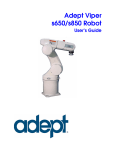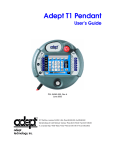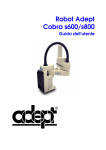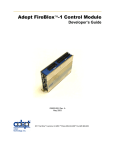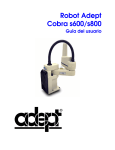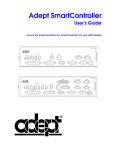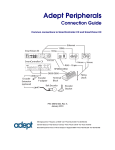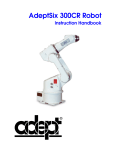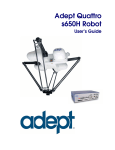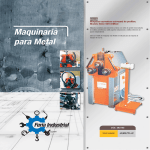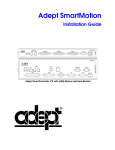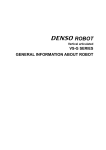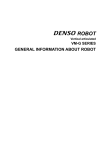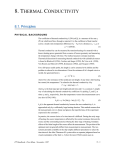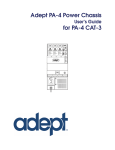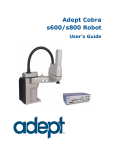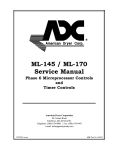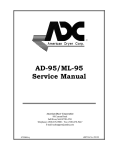Download adept technology Adept XSYS User`s guide
Transcript
AdeptViper s650/s850 Robot User’s Guide AdeptViper s650/s850 Robot User’s Guide P/N: 05173-000, Rev A August 2005 3011 Triad Drive • Livermore, CA 94551 • USA • Phone 925.245.3400 • Fax 925.960.0452 Otto-Hahn-Strasse 23 • 44227 Dortmund • Germany • Phone 49.231.75.89.40 • Fax 49.231.75.89.450 41, rue du Saule Trapu • 91300 • Massy • France • Phone 33.1.69.19.16.16 • Fax 33.1.69.32.04.62 The information contained herein is the property of Adept Technology, Inc., and shall not be reproduced in whole or in part without prior written approval of Adept Technology, Inc. The information herein is subject to change without notice and should not be construed as a commitment by Adept Technology, Inc. This manual is periodically reviewed and revised. Adept Technology, Inc., assumes no responsibility for any errors or omissions in this document. Critical evaluation of this manual by the user is welcomed. Your comments assist us in preparation of future documentation. Please email your comments to: [email protected]. Copyright 2005 by Adept Technology, Inc. All rights reserved. The Adept logo, AdeptVision, AIM, HexSight, and HexaVision are registered trademarks of Adept Technology, Inc. ActiveV, Adept, Adept 1060, Adept 1060+, Adept 1850, Adept 1850 XP, Adept 540, Adept 560, Adept C40, Adept C60, Adept CC, Adept Cobra 550, Adept Cobra 550 CleanRoom, Adept Cobra 600, Adept Cobra 800, Adept Cobra i600, Adept Cobra i800, Adept Cobra s600, Adept Cobra s800, Adept DeskTop, Adept Digital Workcell, Adept FFE, Adept FlexFeeder 250, Adept IC, Adept Impulse Feeder, Adept LineVision, Adept MC, Adept MV, Adept MV-10, Adept MV-19, Adept MV4, Adept MV-5, Adept MV-8, Adept NanoBonder EBS, Adept NanoBonder LWS, Adept NanoCell, Adept NanoStage L1P2, Adept NanoStage L3, Adept NanoStage L3P2, Adept OC, Adept SmartAmp, Adept SmartAxis, Adept SmartController CS, Adept SmartController CX, Adept SmartModule, Adept SmartMotion, Adept SmartServo, Adept sDIO, Adept Servo Kit, Adept sMI6, Adept SMIF-EZ, AdeptAlign 650, AdeptAtlas, AdeptCartesian, AdeptForce, AdeptFTP, AdeptGEM, AdeptModules, AdeptMotion, AdeptMotion Servo, AdeptMotion VME, AdeptNet, AdeptNFS, AdeptOne, AdeptOne-MV, AdeptOne-XL, AdeptRAPID, AdeptSix 300, AdeptSix 300CL, AdeptSix 600, AdeptTCP/IP, AdeptThree, AdeptThree-MV, AdeptThree-XL, AdeptTwo, AdeptVicron, AdeptVicron 300S, AdeptVicron 310D, AdeptVision AVI, AdeptVision AGS, AdeptVision GV, AdeptVision I, AdeptVision II, AdeptVision VME, AdeptVision VXL, AdeptVision XGS, AdeptVision XGS II, AdeptWindows, AdeptWindows Controller, AdeptWindows DDE, AdeptWindows Offline Editor, AdeptWindows PC, AIM Command Server, AIM Dispense, AIM PCB, AIM VisionWare, A-Series, AutoCal, AutoTune, AutoWidth, CCM, CCMII, CGM, FlexFeedWare, HyperDrive, Microenvironment, MicroV+, MotionWare, ObjectFinder, ObjectFinder 2000, PackOne, PalletWare, SMIF-C, SMIF-EZX, SMIF-Z, SMIF-ZX, S-Series, UltraOne, V, V+, and VisionTeach are trademarks of Adept Technology, Inc. Any trademarks from other companies used in this publication are the property of those respective companies. Printed in the United States of America Table of Contents 1 Introduction . . . . . . . . . . . . . . . . . . . . . . . . . . . . . . . . . . . . . . . . . . . . . . . . 9 1.1 Product Description. . . . . . . . . . . . . . . . . . . . . . . . . . . . . . . . . . . . . . . . . . . . . . . . . 9 AdeptViper s650/s850 Robots. . . . . . . . . . . . . . . . . . . . . . . . . . . . . . . . . . . . . . 9 Adept SmartController CX . . . . . . . . . . . . . . . . . . . . . . . . . . . . . . . . . . . . . . . 10 Adept PA-4 CAT-3 Power Chassis . . . . . . . . . . . . . . . . . . . . . . . . . . . . . . . . . . 10 1.2 Installation Overview . . . . . . . . . . . . . . . . . . . . . . . . . . . . . . . . . . . . . . . . . . . . . . 11 1.3 Manufacturer’s Declaration . . . . . . . . . . . . . . . . . . . . . . . . . . . . . . . . . . . . . . . . . 11 1.4 How Can I Get Help? . . . . . . . . . . . . . . . . . . . . . . . . . . . . . . . . . . . . . . . . . . . . . . 12 Related Manuals . . . . . . . . . . . . . . . . . . . . . . . . . . . . . . . . . . . . . . . . . . . . . . . 12 Adept Document Library . . . . . . . . . . . . . . . . . . . . . . . . . . . . . . . . . . . . . . . . 12 2 Safety . . . . . . . . . . . . . . . . . . . . . . . . . . . . . . . . . . . . . . . . . . . . . . . . . . . . 13 2.1 Dangers, Warnings, Cautions, and Notes . . . . . . . . . . . . . . . . . . . . . . . . . . . . . . 13 2.2 Precautions and Required Safeguards . . . . . . . . . . . . . . . . . . . . . . . . . . . . . . . 14 Definition of a Manipulating Industrial Robot . . . . . . . . . . . . . . . . . . . . . . . Safety Barriers . . . . . . . . . . . . . . . . . . . . . . . . . . . . . . . . . . . . . . . . . . . . . . . . . . Impact and Trapping Points . . . . . . . . . . . . . . . . . . . . . . . . . . . . . . . Hazards From Expelling a Part or Attached Tooling . . . . . . . . . . . . Additional Safety Information . . . . . . . . . . . . . . . . . . . . . . . . . . . . . . 14 14 14 15 15 2.3 Risk Assessment. . . . . . . . . . . . . . . . . . . . . . . . . . . . . . . . . . . . . . . . . . . . . . . . . . . 17 Exposure . . . . . . . . . . . . . . . . . . . . . . . . . . . . . . . . . . . . . . . . . . . . . . . . . . . . . . Severity of Injury . . . . . . . . . . . . . . . . . . . . . . . . . . . . . . . . . . . . . . . . . . . . . . . . Avoidance . . . . . . . . . . . . . . . . . . . . . . . . . . . . . . . . . . . . . . . . . . . . . . . . . . . . Control System Behavior Category . . . . . . . . . . . . . . . . . . . . . . . . . . . . . . . . 17 17 18 18 2.4 Intended Use of the Robots . . . . . . . . . . . . . . . . . . . . . . . . . . . . . . . . . . . . . . . . . 19 2.5 Robot Modifications . . . . . . . . . . . . . . . . . . . . . . . . . . . . . . . . . . . . . . . . . . . . . . . 20 Acceptable Modifications . . . . . . . . . . . . . . . . . . . . . . . . . . . . . . . . . . . . . . . 20 Unacceptable Modifications . . . . . . . . . . . . . . . . . . . . . . . . . . . . . . . . . . . . 20 2.6 Transport. . . . . . . . . . . . . . . . . . . . . . . . . . . . . . . . . . . . . . . . . . . . . . . . . . . . . . . . . 21 2.7 Safety Requirements for Additional Equipment . . . . . . . . . . . . . . . . . . . . . . . . . 21 2.8 Working Areas . . . . . . . . . . . . . . . . . . . . . . . . . . . . . . . . . . . . . . . . . . . . . . . . . . . 21 2.9 Qualification of Personnel . . . . . . . . . . . . . . . . . . . . . . . . . . . . . . . . . . . . . . . . . . 22 2.10 Safety Equipment for Operators . . . . . . . . . . . . . . . . . . . . . . . . . . . . . . . . . . . . 22 2.11 Protection Against Unauthorized Operation. . . . . . . . . . . . . . . . . . . . . . . . . . . 23 2.12 Safety Aspects While Performing Maintenance . . . . . . . . . . . . . . . . . . . . . . . 23 2.13 Risks That Cannot Be Avoided . . . . . . . . . . . . . . . . . . . . . . . . . . . . . . . . . . . . . . 23 AdeptViper s650s/850 Robot User’s Guide, Rev A 5 Table of Contents 2.14 Risks Due to Incorrect Installation or Operation . . . . . . . . . . . . . . . . . . . . . . . . 23 2.15 What to Do in an Emergency Situation . . . . . . . . . . . . . . . . . . . . . . . . . . . . . . . 24 3 Robot Installation . . . . . . . . . . . . . . . . . . . . . . . . . . . . . . . . . . . . . . . . . . . 25 3.1 Unpacking and Inspecting the Adept Equipment . . . . . . . . . . . . . . . . . . . . . . . 25 Before Unpacking . . . . . . . . . . . . . . . . . . . . . . . . . . . . . . . . . . . . . . . . . . . . . . . 25 Upon Unpacking . . . . . . . . . . . . . . . . . . . . . . . . . . . . . . . . . . . . . . . . . . . . . . . . 25 3.2 Environmental and Facility Requirements . . . . . . . . . . . . . . . . . . . . . . . . . . . . . 26 3.3 Transporting the Robot . . . . . . . . . . . . . . . . . . . . . . . . . . . . . . . . . . . . . . . . . . . . . 27 Precautions in Transporting Robot . . . . . . . . . . . . . . . . . . . . . . . . . . . . . . . . . 27 Transport Procedure . . . . . . . . . . . . . . . . . . . . . . . . . . . . . . . . . . . . . . . . . . . . . 28 3.4 Mounting the Robot . . . . . . . . . . . . . . . . . . . . . . . . . . . . . . . . . . . . . . . . . . . . . . . 30 3.5 Grounding the Robot . . . . . . . . . . . . . . . . . . . . . . . . . . . . . . . . . . . . . . . . . . . . . . 31 3.6 Description of Connectors on Robot Interface Panel . . . . . . . . . . . . . . . . . . . . 32 3.7 Air Lines and Signal Wiring . . . . . . . . . . . . . . . . . . . . . . . . . . . . . . . . . . . . . . . . . . 33 3.8 Designing End-Effectors . . . . . . . . . . . . . . . . . . . . . . . . . . . . . . . . . . . . . . . . . . . . 35 Mass of End-Effector . . . . . . . . . . . . . . . . . . . . . . . . . . . . . . . . . . . . . . . . . . . . 35 Center of Gravity Position of End-Effector . . . . . . . . . . . . . . . . . . . . . . . . . . . 35 Moment of Inertia Around J4, J5 and J6 . . . . . . . . . . . . . . . . . . . . . . . . . . . . 36 4 System Installation . . . . . . . . . . . . . . . . . . . . . . . . . . . . . . . . . . . . . . . . . . 39 4.1 System Cable Diagram . . . . . . . . . . . . . . . . . . . . . . . . . . . . . . . . . . . . . . . . . . . . . 39 4.2 Installing the SmartController . . . . . . . . . . . . . . . . . . . . . . . . . . . . . . . . . . . . . . . . 40 4.3 Installing the PA-4 Power Chassis . . . . . . . . . . . . . . . . . . . . . . . . . . . . . . . . . . . . 40 4.4 Connecting 3-Phase AC Power to PA-4 . . . . . . . . . . . . . . . . . . . . . . . . . . . . . . . 42 PA-4 3-Phase Power Requirements . . . . . . . . . . . . . . . . . . . . . . . . . . . . . . . . . 42 Connecting the PA-4 3-Phase AC Power Cord to AC Supply . . . . . . . . . . 43 Typical 3-Phase AC Power Installation Diagrams. . . . . . . . . . . . . . . . . . . . . . 44 4.5 Connecting 1-Phase AC Power to PA-4 . . . . . . . . . . . . . . . . . . . . . . . . . . . . . . . 45 PA-4 1-Phase AC Power Requirements . . . . . . . . . . . . . . . . . . . . . . . . . . . . . 45 Connecting the PA-4 1-Phase AC Power Cord to AC Supply . . . . . . . . . . . 45 Typical Single Phase, 220 VAC Power Installation Diagrams . . . . . . . . . . . . 47 5 System Operation . . . . . . . . . . . . . . . . . . . . . . . . . . . . . . . . . . . . . . . . . . 49 5.1 System Start-up Procedure . . . . . . . . . . . . . . . . . . . . . . . . . . . . . . . . . . . . . . . . . 49 5.2 Learning to Program the Robot. . . . . . . . . . . . . . . . . . . . . . . . . . . . . . . . . . . . . . . 50 5.3 Connecting Digital I/O to the System . . . . . . . . . . . . . . . . . . . . . . . . . . . . . . . . . 51 5.4 Installing Axis Labels . . . . . . . . . . . . . . . . . . . . . . . . . . . . . . . . . . . . . . . . . . . . . . . 53 5.5 Caution Label on Robot . . . . . . . . . . . . . . . . . . . . . . . . . . . . . . . . . . . . . . . . . . . . 54 6 AdeptViper s650s/850 Robot User’s Guide, Rev A Table of Contents 5.6 Status Panel Codes on sDAI Module . . . . . . . . . . . . . . . . . . . . . . . . . . . . . . . . . . 55 6 Maintenance . . . . . . . . . . . . . . . . . . . . . . . . . . . . . . . . . . . . . . . . . . . . . . 57 6.1 Installing and Using Brake Release Box . . . . . . . . . . . . . . . . . . . . . . . . . . . . . . . 57 6.2 Replacing Encoder Backup Battery . . . . . . . . . . . . . . . . . . . . . . . . . . . . . . . . . . 58 6.3 Installing User-Supplied Hardstops . . . . . . . . . . . . . . . . . . . . . . . . . . . . . . . . . . . 61 7 Technical Specifications . . . . . . . . . . . . . . . . . . . . . . . . . . . . . . . . . . . . . 63 7.1 Robot Dimensions . . . . . . . . . . . . . . . . . . . . . . . . . . . . . . . . . . . . . . . . . . . . . . . . . 63 7.2 Robot Flange Dimensions . . . . . . . . . . . . . . . . . . . . . . . . . . . . . . . . . . . . . . . . . . 67 7.3 Specifications . . . . . . . . . . . . . . . . . . . . . . . . . . . . . . . . . . . . . . . . . . . . . . . . . . . . 68 Index . . . . . . . . . . . . . . . . . . . . . . . . . . . . . . . . . . . . . . . . . . . . . . . . . . . . . . . . 71 AdeptViper s650s/850 Robot User’s Guide, Rev A 7 Table of Contents 8 AdeptViper s650s/850 Robot User’s Guide, Rev A Introduction 1.1 1 Product Description AdeptViper s650/s850 Robots The AdeptViper s650 and AdeptViper s850 are high-performance, six-axis robots designed specifically for assembly applications. The speed and precision of the AdeptViper robots also make them ideal for material handling, packaging, machine tending, and many other operations requiring fast and precise automation. NOTE: The descriptions and instructions in this manual apply to both the AdeptViper s650 and the AdeptViper s850, except for instances where there is a difference, as in dimension and work envelope drawings. In those cases the information is presented for both robots. Second arm 3rd-axis motor cover (rear side) 4th axis (J4) 4th-axis cover (+) Second arm cover (+) (+) (-) (+) (-) (-) 5th axis (J5) 6th axis (J6) (-) 3rd axis (J3) First arm (+) 2nd-axis motor cover (rear side) 2nd axis (J2) (-) (-) Base (+) 1st axis (J1) Figure 1-1. Robot Axis Identification AdeptViper s650/s850 Robot User’s Guide, Rev A 9 Chapter 1 - Introduction Adept SmartController CX The SmartController CX is the foundation of Adept’s family of high-performance distributed motion and vision controllers. The SmartController CX is designed for use with Adept Cobra s600 and s800 robots, Adept SmartModules, the AdeptViper robot, and the Adept sMI6 Module for the SmartMotion product. The SmartController CX supports an integrated vision option and a conveyor tracking option. It offers scalability and support for IEEE 1394-based digital I/O and general motion expansion modules. The IEEE 1394 interface is the backbone of Adept SmartServo, Adept's distributed controls architecture supporting Adept products. The controller also includes Fast Ethernet and DeviceNet. SmartServo OK HPE LAN SF ES HD 1.1 SW1 1 2 3 4 1.2 IEEE-1394 2.1 Device Net 2.2 RS-232/TERM RS-422/485 RS-232-1 RS-232-2 Eth 10/100 BELT ENCODER ON OFF 1 2 3 XDIO XUSR XSYS XFP XMCP XDC1 XDC2 24V 5A -+ -+ SmartController CX *S/N 3562-XXXXX* CAMERA R Figure 1-2. Adept SmartController CX Adept PA-4 CAT-3 Power Chassis The PA-4 CAT-3 includes AC-DC power conversion electronics that supports a range of Adept power amplifiers and robot control modules. In addition, the PA-4 CAT-3 includes dual (redundant) high-power AC contactors that, in combination with the sDAI, meet the Category-3 E-Stop requirements per EN-954. The PA-4 is configured with J Amplifier modules to support the AdeptViper robot systems. The J amplifiers in the AdeptViper robot system are controlled by the sDAI distributed control module. The sDAI module resides in the PA-4 chassis and contains a RISC microprocessor and interface circuitry that close the servo loops for high- performance robot motion. The sDAI is connected to a host Adept SmartController via the SmartServo interface (based on IEEE 1394). 10 AdeptViper s650/s850 Robot User’s Guide, Rev A Installation Overview 1.2 Installation Overview The system installation process is summarized in the following table. Refer also to the system cable diagram in Figure 4-1 on page 39. Table 1-1. Installation Overview 1.3 Task to be Performed Reference Location 1. Mount the robot on a flat, secure mounting surface. See Section 3.4 on page 30. 2. Install the SmartController, Front Panel, and AdeptWindows software. See Section 4.2 on page 40. 3. Install the PA-4 power chassis. See Section 4.3 on page 40. 4. Install the Arm Power/Signal cable between the PA-4 and the robot. See Section 4.3 on page 40. 5. Install the IEEE 1394 and XSYS cables between the PA-4 and SmartController. See Section 4.3 on page 40. 6. Connect AC power to PA-4 power chassis. See Section 4.4 on page 42. 7. Start AdeptWindows, connect to the controller, and turn on power to the system. See Section 5.1 on page 49. Manufacturer’s Declaration The Manufacturer’s Declaration of Incorporation and Conformity for AdeptViper robot systems can be found on the Adept Website, in the Download Center of the Support section. http://www.adept.com/support/downloads_disclaimer.asp In the Download Types search box, select Regulatory Certificates to find the document, which you can then download. AdeptViper s650/s850 Robot User’s Guide, Rev A 11 Chapter 1 - Introduction 1.4 How Can I Get Help? Refer to the How to Get Help Resource Guide (Adept P/N 00961-00700) for details on getting assistance with your Adept software and hardware. Additionally, you can access information sources on Adept’s corporate web site: http://www.adept.com Related Manuals This manual covers the installation, operation, and maintenance of an Adept Cobra s600/s800 robot system. There are additional manuals that cover programming the system, reconfiguring installed components, and adding other optional components; see Table 1-2. These manuals are available on the Adept Document Library CD-ROM shipped with each system. Table 1-2. Related Manuals Manual Title Description Adept SmartController User’s Guide Contains complete information on the installation and operation of the Adept SmartController and the optional sDIO product. Adept PA-4 Power Chassis User’s Guide Contains complete information on the installation and operation of the PA-4 Power Chassis. AdeptWindows Installation Guide Describes installation of AdeptWindows software. Instructions for Adept Utility Programs Describes the utility programs used for advanced system configurations, system upgrades, file copying, and other system configuration procedures. V+ Operating System User’s Guide Describes the V+ operating system, including disk file operations, monitor commands, and monitor command programs. V+ Language User’s Guide Describes the V+ language and programming of an Adept control system. Adept Document Library The Adept Document Library (ADL) contains documentation for Adept products. You can access a local copy of the ADL from the Adept Software CD shipped with your system, or from the separate ADL CD. Additionally, an Internet version of the ADL can be accessed by going to the Adept Web site and selecting Document Library from the home page. To go directly to the Adept Document Library, type the following URL into your browser: http://www.adept.com/Main/KE/DATA/adept_search.htm To locate information on a specific topic, use the Document Library search engine on the ADL main page. To view a list of available product documentation, select the Document Titles option. 12 AdeptViper s650/s850 Robot User’s Guide, Rev A Safety 2.1 2 Dangers, Warnings, Cautions, and Notes There are four levels of special alert notation used in this manual. In descending order of importance, they are: DANGER: This indicates an imminently hazardous situation which, if not avoided, will result in death or serious injury. WARNING: This indicates a potentially hazardous situation which, if not avoided, could result in serious injury or major damage to the equipment. CAUTION: This indicates a situation which, if not avoided, could result in minor injury or damage to the equipment. NOTE: This provides supplementary information, emphasizes a point or procedure, or gives a tip for easier operation. AdeptViper s650/s850 Robot User’s Guide, Rev A 13 Chapter 2 - Safety 2.2 Precautions and Required Safeguards This manual must be read by all personnel who install, operate, or maintain Adept systems, or who work within or near the workcell. CAUTION: Adept Technology strictly prohibits installation, commissioning, or operation of an Adept robot without adequate safeguards. These must be compliant with applicable local and national standards. Installations in EU and EEA countries must comply with EN 775/ISO 10218, especially sections 5,6; EN 292-2; and EN 60204-1, especially section 13. Definition of a Manipulating Industrial Robot The definition of a manipulating robot according to (ISO 10218:1992(E)) is as follows: “A manipulating robot is an automatically controlled, reprogrammable, multipurpose, manipulative machine with several degrees of freedom, which may be either fixed in place or mobile for use in industrial automation applications.” Safety Barriers Safety barriers must be provided that prevent personnel from entering the workcell whenever power is applied to the equipment. Adept systems are computer-controlled and may activate remote devices under program control at times or along paths not anticipated by personnel. It is critical that safeguards be in place to prevent personnel from entering the workcell whenever power to the equipment is present. The robot system integrator (user or operator) must ensure that adequate safeguards, safety barriers, light curtains, safety gates, safety floor mats, etc., are installed. The robot workcell must comply with applicable local and national standards (see Section 2.7 on page 21). The height and the distance of the safety fence from the robot must ensure that personnel cannot reach the danger zone of the robot. The Adept control system has features that aid the user in constructing system safeguards, including customer emergency stop circuitry and digital input and output lines. The emergency power-off circuitry is capable of switching external power systems and can be interfaced to the appropriate user-supplied safeguards. See the Adept SmartController User’s Guide for additional information. Impact and Trapping Points Adept robots are capable of moving at high speeds. If a person is struck by a robot (impacted) or trapped (pinched) serious injury could occur. Robot configuration, joint speed, joint orientation, and attached payload all contribute to the total amount of energy available to cause injury. 14 AdeptViper s650/s850 Robot User’s Guide, Rev A Precautions and Required Safeguards Hazards From Expelling a Part or Attached Tooling The maximum joint tip speeds that can be achieved by the robot are listed in Table 9-1 on page 83. Any tooling, fixtures, end-effectors, etc., mounted to the user flange, or one of the other axes of the robot must be attached by sufficient means to resist being expelled from the robot. Additionally, any payload must be held by the end-effector in a manner that prevents the payload from being expelled accidentally. The safety fence or barrier constructed around the robot must be designed to withstand the impact of any item expelled accidentally from the robot. Projectile energy can be calculated using the formula E = 1--- mv2. 2 NOTE: In the Projectile energy formula above: •E = Energy •M = Mass •V = Velocity Additional Safety Information The standards and regulations listed in this handbook contain additional guidelines for robot system installation, safeguarding, maintenance, testing, start-up, and operator training. Table 2-1 on page 16 lists some sources for the various standards. AdeptViper s650/s850 Robot User’s Guide, Rev A 15 Chapter 2 - Safety Table 2-1. Sources for International Standards and Directives SEMI International Standards 3081 Zanker Road San Jose, CA 95134 USA American National Standards Institute (ANSI) 11 West 42nd Street, 13th Floor New York, NY 10036 USA Phone: 1.408.943.6900 Fax: 1.408.428.9600 Phone 212-642-4900 Fax 212-398-0023 http://wps2a.semi.org/wps/portal/_pagr/118/_p a.118/200 http://www.ansi.org BSI Group (British Standards) 389 Chiswick High Road London W4 4AL United Kingdom Document Center, Inc. 1504 Industrial Way, Unit 9 Belmont, CA 94002 USA Phone +44 (0)20 8996 9000 Fax +44 (0)20 8996 7400 Phone 415-591-7600 Fax 415-591-7617 http://www.bsi-global.com http://www.document-center.com DIN, Deutsches Institut für Normung e.V. German Institute for Standardization Burggrafenstrasse 6 10787 Berlin Germany Global Engineering Documents 15 Inverness Way East Englewood, CO 80112 USA Phone.: +49 30 2601-0 Fax: +49 30 2601-1231 Phone 800-854-7179 Fax 303-397-2740 http://global.ihs.com http://www.din.de http://www2.beuth.de/ (publishing) 16 IEC, International Electrotechnical Commission Rue de Varembe 3 PO Box 131 CH-1211 Geneva 20 Switzerland Robotic Industries Association (RIA) 900 Victors Way PO Box 3724 Ann Arbor, MI 48106 USA Phone 41 22 919-0211 Fax 41 22 919-0300 Phone 313-994-6088 Fax 313-994-3338 http://www.iec.ch http://www.robotics.org AdeptViper s650/s850 Robot User’s Guide, Rev A Risk Assessment 2.3 Risk Assessment Without special safeguards in its control system, the AdeptViper robot could inflict serious injury on an operator working within its work envelope. Safety standards in several countries require appropriate safety equipment to be installed as part of the system. Table 2-2 lists some of the safety standards that affect industrial robots. It is not a complete list. Safeguards must comply with all applicable local and national standards for the location where the robot is installed. Table 2-2. Partial List of Robot and Machinery Safety Standards International USA Canada ISO 10218 Europe EN 775 ANSI/RIA R15.06 CAN/CSAZ434-94 Title of Standard Manipulating Industrial Robots Safety Industrial Robots and Robot Systems - Safety Requirements EN 292-2 Safety of Machinery - Basic Concepts, General Principles for Design EN 954-1 Safety Related Parts of Control Systems - General Principles for Design EN 1050 Safety of Machinery - Risk Assessment Adept has performed a Risk Assessment for this product, based on the intended applications of the robot. The conclusions are summarized below. Exposure When arm power is on, all personnel must be kept out of the robot work envelope by interlocked perimeter barriers. The only permitted exception is for teaching the robot in Manual Mode by a skilled programmer (see “Qualification of Personnel” on page 22), who must wear safety equipment (see “Safety Equipment for Operators” on page 22) and carry the pendant (T1 or MCP). Therefore, exposure of personnel to hazards related to the robot is limited (seldom and/or short exposure time). Severity of Injury Provided that skilled personnel who enter the robot work envelope are wearing protective headgear, eyeglasses, and safety shoes, it is likely that any injuries caused by the robot would be slight (normally reversible). AdeptViper s650/s850 Robot User’s Guide, Rev A 17 Chapter 2 - Safety Avoidance Due to its light payload capacity, it is likely that such personnel could avoid being hit by the robot even in a high-acceleration, runaway, failure condition. However, the programmer must always carry the pendant when inside the work envelope, as the pendant provides both E-Stop and Enabling switch functions. For normal operation (AUTO mode), user-supplied interlocked guarding must be installed to prevent any person entering the workcell while Arm Power is on. DANGER: The Adept-supplied system components provide a Category 1 control system as defined by EN 954. The robot system must be installed with user-supplied interlock barriers. The interlocked barrier should interrupt the DC and AC supplies to the control system in the event of personnel attempting to enter the workcell when Arm Power is enabled, except for teaching in Manual Mode. Failure to install suitable guarding could result in injury or death. The Risk Assessment for teaching this product depends on the application. In many applications, the programmer will need to enter the robot workcell while Arm Power is enabled to teach the robot. Other applications can be designed so that the programmer does not have to enter the work envelope while Arm Power is on. Examples of alternative methods of programming include: 1. Programming from outside the safety barrier. 2. Programming with Arm Power off. 3. Copying program from another (master) robot. 4. Off-line or CAD programming. Control System Behavior Category The following paragraphs relate to the requirements of European (EU/EEA) directives for Machinery, Electric Safety, and Electromagnetic Compatibility (EMC). In situations with low exposure consideration factors, European Standard EN 1050 specifies use of a Category 1 Control System per EN 954. EN 954 defines a Category 1 Control System as one that employs Category B components designed to withstand environmental influences, such as voltage, current, temperature, EMI, and well-tried safety principles. The standard control system described in this handbook employs hardware components in its safety system that meet or exceed the requirements of the EU Machinery Directive and Low Voltage Directive. The standard control system is fully hardened to all EMI influences per the EU EMC Directive and meets all functional requirements of ISO 10218 (EN 775) Manipulating Robots Safety. In addition, a software-based reduced speed mode has been incorporated to limit speed and impact forces on the Operator and production tooling when the robot is operated in Manual Mode. 18 AdeptViper s650/s850 Robot User’s Guide, Rev A Intended Use of the Robots The standard control system meets or exceeds the requirements imposed by the EN 954 specified Category 1 level of safety. 2.4 Intended Use of the Robots The installation and use of Adept products must comply with all safety instructions and warnings in this manual. Installation and use must also comply with all applicable local and national requirements and safety standards (see Section 2.7 on page 21). The AdeptViper robots are intended for use in parts assembly and material handling for payloads less than 5 kg. See Chapter 5 for complete information tooling and payloads. CAUTION: For safety reasons, it is prohibited to make certain modifications to Adept robots (see Section 2.5). The Adept controller is a component subassembly of a complete industrial automation system. The controller subassembly must be installed inside a suitable enclosure. The controller subassembly must not come into contact with liquids. Additionally, the robot must not come into contact with liquids. The Adept equipment is not intended for use in any of the following situations: • In hazardous (explosive) atmospheres • In mobile, portable, marine, or aircraft systems • In life-support systems • In residential installations • In situations where the Adept equipment will be subject to extremes of heat or humidity. CAUTION: The instructions for operation, installation, and maintenance given in this manual must be strictly observed. Non-intended use of an AdeptViper robot can: • Cause injury to personnel • Damage the robot or other equipment • Reduce system reliability and performance AdeptViper s650/s850 Robot User’s Guide, Rev A 19 Chapter 2 - Safety All persons that install, commission, operate, or maintain the robot must: • Have the necessary qualifications • Read and follow the instructions in this Instruction Handbook exactly If there is any doubt concerning the application, ask Adept to determine if it is an intended use or not. 2.5 Robot Modifications It is sometimes necessary to modify the robot in order to successfully integrate it into a workcell. Unfortunately, many seemingly simple modifications can either cause a robot failure or reduce the robot’s performance, reliability, or lifetime. The following information is provided as a guideline to modifications. Acceptable Modifications In general, the following robot modifications do not cause problems, but may affect robot performance: • Attaching tooling, utility boxes, solenoid packs, vacuum pumps, cameras, lighting, etc., to the robot tool mount flange. • Attaching hoses, pneumatic lines, or cables to the robot. These should be designed so they do not restrict joint motion or cause robot motion errors. Unacceptable Modifications The modifications listed below may damage the robot, reduce system safety and reliability, or shorten the life of the robot. The warranty of the entire robot or certain parts may be voided. CAUTION: Making any of the modifications outlined below voids the warranty of any components that Adept determines were damaged due to the modification. You must contact Adept Customer Service if you are considering any of the following modifications: • Modifying any of the robot harnesses or robot-to-controller cables. • Modifying any robot access covers or drive system components. • Modifying, including drilling or cutting, any robot surface. • Modifying any robot electrical component or printed-circuit board. • Routing additional hoses, air lines, or wires through the inside of the robot. • Modifications that compromise EMC performance, including shielding. 20 AdeptViper s650/s850 Robot User’s Guide, Rev A Transport 2.6 Transport Always use adequate equipment to transport and lift Adept products. See Chapter 3 for more information on transporting, lifting, and installing. 2.7 Safety Requirements for Additional Equipment Additional equipment used with the AdeptViper robots (grippers, conveyor belts, etc.) must not reduce the workcell safeguards. Emergency stop switches must be accessible at all times. If the robot is to be used in an EU or EEA member country, all components in the robot workcell must comply with the safety requirements in the European Machine Directive 89/392/EEC (and subsequent amendments) and related harmonized European, international, and national standards. For robot systems, these include: EN 775/ISO 10218, sections 5,6; EN 292-2; and EN 60204. For safety fences, see EN 294. In other countries, Adept strongly recommends, that a similar level of safety be obtained as well as complying with the applicable local and national regulations, including SEMI-S2. In the USA, applicable standards include ANSI/RIA R15.06 and ANSI/UL 1740. In Canada, applicable standards include CAN/CSA Z434. 2.8 Working Areas Adept robots have a Manual and an Automatic (AUTO) operating mode. While in Automatic Mode, personnel are not allowed in the workcell. In Manual Mode, operators with additional safety equipment (see Section 2.10 on page 22) are allowed to work in the robot workcell. For safety reasons the operator should, whenever possible, stay outside of the robot work envelope to prevent injury. The maximum speed and power of the robot is reduced, but it could still cause injury to the operator. Before performing maintenance in the working envelope of the robot, High Power must be switched off and the power supply of the robot must be disconnected. After these precautions, a skilled person is allowed to perform maintenance on the robot. See Section 2.9 for the specifications. CAUTION: Never remove any safeguarding and never make changes in the system that will decommission a physical safeguard. AdeptViper s650/s850 Robot User’s Guide, Rev A 21 Chapter 2 - Safety 2.9 Qualification of Personnel This manual assumes that all personnel have attended an Adept training course and have a working knowledge of the system. The user must provide the necessary additional training for all personnel who will be working with the system. As noted in this handbook, certain procedures should be performed only by skilled or instructed persons. For a description of the level of qualification, Adept uses the standard terms: • Skilled persons have technical knowledge or sufficient experience to enable them to avoid the dangers, electrical and/or mechanical. • Instructed persons are adequately advised or supervised by skilled persons to enable them to avoid the dangers, electrical and/or mechanical. All personnel must observe industry-prescribed safety practices during the installation, operation, and testing of all electrically powered equipment. To avoid injury or damage to equipment, always remove power by disconnecting the AC power from the source before attempting any repair or upgrade activity. Use appropriate lockout procedures to reduce the risk of power being restored by another person while you are working on the system. WARNING: The user must get confirmation from every entrusted person before they start working with the robot that the person: 1. Has received the manual 2. Has read the manual 3. Understands the manual 4. Will work in the manner specified by the manual. 2.10 Safety Equipment for Operators Operators must wear safety equipment in the workcell. For safety reasons, operators must wear the following when they are in the robot workcell. • Safety glasses • Protective headgear (hard hats) • Safety shoes Warning signs should be posted around the workcell to ensure that anyone working around the robot system knows they must wear safety equipment. 22 AdeptViper s650/s850 Robot User’s Guide, Rev A Protection Against Unauthorized Operation 2.11 Protection Against Unauthorized Operation The system must be protected against unauthorized use. The user or operator must restrict access to the keyboard and the pendant by locking them in a cabinet or use another adequate method to prevent access to them. 2.12 Safety Aspects While Performing Maintenance Only skilled persons with the necessary knowledge about the safety and operating the equipment are allowed to maintain the robot, controller, and power chassis. CAUTION: During maintenance and repair, the power of the Adept controller must be turned off. Lockout measures must be used to prevent unauthorized personnel from turning on power. 2.13 Risks That Cannot Be Avoided The Adept control system includes devices that disable High Power if a system failure occurs. However, certain residual risks or improper situations could cause hazards. The following situations may result in risks that cannot be avoided: • Failure of software or electronics that may cause high-speed robot motion in Manual Mode • Failure of hardware associated with enabling device or E-Stop system 2.14 Risks Due to Incorrect Installation or Operation Take precautions to ensure that the following situations do not occur: • Purposely defeating any aspect of the safety E-Stop system • Improper installation or programming of the robot system • Unauthorized use of cables other than those supplied or use of modified components in the system • Defeating interlock so that operator can enter workcell with High Power ON • Ejection of work piece (see “Hazards From Expelling a Part or Attached Tooling” on page 15). AdeptViper s650/s850 Robot User’s Guide, Rev A 23 Chapter 2 - Safety 2.15 What to Do in an Emergency Situation Press any E-Stop button (a red push-button on a yellow background/field) and then follow the internal procedures of your company or organization for an emergency situation. If a fire occurs, use CO2 to extinguish the fire. 24 AdeptViper s650/s850 Robot User’s Guide, Rev A Robot Installation 3.1 3 Unpacking and Inspecting the Adept Equipment Before Unpacking Carefully inspect all shipping crates for evidence of damage during transit. Pay special attention to tilt and shock indication labels on the exteriors of the containers, if installed. If any damage is indicated, request that the carrier’s agent be present at the time the container is unpacked. Upon Unpacking Before signing the carrier’s delivery sheet, please compare the actual items received (not just the packing slip) with your equipment purchase order and verify that all items are present and that the shipment is correct and free of visible damage. If the items received do not match the packing slip, or are damaged, do not sign the receipt. Contact Adept as soon as possible. If the items received do not match your order, please contact Adept immediately. Inspect each item for external damage as it is removed from its container. If any damage is evident, contact Adept (see Section 1.4 on page 12). Retain all containers and packaging materials. These items may be necessary to settle claims or, at a later date, to relocate equipment. AdeptViper s650/s850 Robot User’s Guide, Rev A 25 Chapter 3 - Robot Installation 3.2 Environmental and Facility Requirements The Adept robot system installation must meet the operating environment requirements shown in Table 3-1. Table 3-1. Robot System Operating Environment Requirements Item Condition Flatness of the mounting surface 0.1/500 mm Installation type Floor-mount or Overhead-mount Ambient temperature During operation: 0 to 40°C During storage and transportation: -10 to 60°C Humidity During operation: 90% or less (No dew condensation allowed.) During storage and transportation: 75% or less (No dew condensation allowed.) Vibration During operation: 4.9 m/s2 (0.5G) or less During storage and transportation: 29.4 m/s2 (3G) or less Safe Installation Environment The robot should not be installed in an environment where: • there are flammable gases or liquids, • there are any acidic, alkaline or other corrosive gases, • there is sulfuric or other types of cutting or grinding oil mist, or • there are any large-sized inverters, high output/high frequency transmitters, large contactors, welders, or other sources of electrical noise. • there are any shavings from metal processing or other conductive material flying about, • it may be directly exposed to water, oil, or cutting chips. Working space, etc. • Sufficient service space must be available for inspection and disassembly. • Keep wiring space (230 mm or more) behind the robot, and fasten the wiring to the mounting face or beam so that the weight of the cables will not be directly applied to the connectors. Installation conditions 26 Grounding resistance: 100 milliohms or less See Figure 3-3 on page 31. AdeptViper s650/s850 Robot User’s Guide, Rev A Transporting the Robot 3.3 Transporting the Robot Precautions in Transporting Robot • The robot weighs approximately 30 kg. Use a crane suitable for the robot weight. • Have at least two workers handle this job. • Workers should wear helmets, safety shoes, and gloves during transport. • Do not hold the first arm, elbow, either side of the 2nd arm, 2nd-axis cover, or 3rd-axis cover, or apply force to any of them. See Figure 1-1 on page 9. CAUTION: Pass the hoisting wires through the specified eyebolts as illustrated below. Passing them through other sections may drop the robot unit, resulting in injuries to personnel or damage to the robot. Wire (Belt sling) Waste Cloth Eyebolts Robot Mounting Bolts Figure 3-1. Robot in Hoisting Sling AdeptViper s650/s850 Robot User’s Guide, Rev A 27 Chapter 3 - Robot Installation Transport Procedure Step Procedure Drawing 1 Before transportation, set the robot in a transport position as shown at right by manually moving the second, third and fourth axes. When unpacked first, the robot is in the transport position, so this job is not required. Transport Position 2 Axis Angle First axis (J1) 0° Second axis (J2) -145° Third axis (J3) +243° Fourth axis (J4) -90° Fifth axis (J5) -90° Disconnect the robot control cable, air piping and user signal cables from the robot unit. When the robot unit is first unpacked, this job is not required. 3 As shown at right, mount the eyebolts. When delivered, the robot unit is packed with eyebolts attached, so this job is not required Eyebolts 28 AdeptViper s650/s850 Robot User’s Guide, Rev A Transporting the Robot Step Procedure Drawing 4 As shown at right, place a waste cloth on the second arm and pass the wire through the two eyebolts. Wire (Belt sling) Note: Before transporting the robot, check that the path to the target position is free of obstacles. Waste Cloth Eyebolts Robot Mounting Bolts 5 Worker A: Remove the four bolts while supporting the robot unit to prevent it from getting overturned. 6 Worker B: Operate the crane and move the robot unit to the target site. 7 Worker B: Put the robot unit down in the target position. Worker A: Temporarily secure the robot unit with four bolts. 8 Secure the robot unit according to the instructions in Section 3.4 on page 30. 9 Remove the eyebolts from the robot unit. Caution: Before running the robot unit, be sure to remove the eyebolts. Otherwise, the robot arm will strike against those eyebolts. AdeptViper s650/s850 Robot User’s Guide, Rev A 29 Chapter 3 - Robot Installation 3.4 Mounting the Robot 200 160 +0.012 2X Ø6 - 0 66 ±0.05 142.3 200 160 184 ±0.05 R20 4X Ø12 THRU For M10 Diamond-shaped pin Figure 3-2. Mounting Hole Pattern for Robot 1. See Figure 3-2 for the dimensions of the mounting holes in the robot mounting position where the robot unit is to be secured. • Drill four bolt holes (M10), 20 mm deep or more • Drill a dowel pin hole Ø4, H7 for diamond shaped pin, 10-mm deep or more • Drill a dowel pin hole Ø6, H7 for internally threaded positioning pin, 10-mm deep or more 2. Locate two alignment pins, one round and one diamond-shaped, supplied in the accessory kit. 3. Drive the diamond-shaped pin into the Ø4, H7 hole so that it orients as shown in Figure 3-2. 4. Drive the internally threaded alignment pin into the Ø6, H7 hole. NOTE: Be sure to drive the alignment pins. It can minimize positional deviations that may be caused by the removal/installation of the robot unit for maintenance or the vibration during operation. 30 AdeptViper s650/s850 Robot User’s Guide, Rev A Grounding the Robot 5. Set the robot unit into place on the robot mount. When transporting the robot unit, follow the instructions given in Section 3.3 on page 27. 6. Secure the robot unit to the mount with four bolts and plain washers. • Bolt: M10 x 30 mm (strength class: 12.9) • Tightening torque: 70 +/- 14 Nm 3.5 Grounding the Robot Ground the grounding terminal of the robot unit with a wire of 12 AWG or more. Ground resistance must be less than 100 milliohms. NOTE: Use a dedicated grounding wire and grounding electrode. Do not share them with any other electric power or power equipment such as a welder. WARNING: Wiring must be performed by authorized or certified personnel. Failure to observe this caution may result in fire or electric shock. CN22 AIR1 AIR2 CN20 Grounding terminal (M5) 12 AWG or more Figure 3-3. Ground Point on Robot AdeptViper s650/s850 Robot User’s Guide, Rev A 31 Chapter 3 - Robot Installation 3.6 Description of Connectors on Robot Interface Panel CN22 Power/Signal Cable - to PA-4 C N 22 AIR 1 AIR 1 AIR 2 AIR 2 CN20 CN20 Grounding terminal (M5) Figure 3-4. Robot Interface Panel CN22 - the Arm Power/Signal cable from the PA-4 is installed at this connector. CN20 - Pins 1 to 10 are wired directly to corresponding pins 1 to 10 on CN21 on the upper arm. Pins 12 to 18 are for solenoid control. See Section 3.7 on page 33. AIR 1 - air piping connector (PT1/4) for three solenoids in robot. See Section 3.7 on page 33. AIR 2 - air piping connector (PT1/4), connects directly to AIR 2 on the second (upper) arm. Grounding Terminal - ground point on robot, see Section 3.5 on page 31. 32 AdeptViper s650/s850 Robot User’s Guide, Rev A Air Lines and Signal Wiring 3.7 Air Lines and Signal Wiring The robot is equipped with 7 air pipes, or lines. Six lines, from AIR1 input, are controlled by the 3 internal solenoid valves. One line, from AIR2 input, is connected directly to AIR2 on the second arm. There are 10 user electric lines. The air lines and signal wiring are shown below. Valve Symbols and Air Intake/Exhaust States (1A and 1B are piping joint symbols.) Air piping joint Air intake AIR1 Valve signal Solenoid A B ON OFF OFF ON ON OFF OFF ON ON OFF OFF ON Solenoid Exhaust valve 1A 1B 2A 2B 3A 3B AIR2 1B 1A 2B 2A 3B 3A 1 1 2 2 3 3 CN20 Pin Assignment For controller I/O unit, NPN type (source IN, sink OUT) CN20 pin No. Used for: 12 +24V 13 Solenoid 1A (solenoid valve 1) 14 Solenoid 1B (solenoid valve 1) 15 Solenoid 2A (solenoid valve 2) 16 Solenoid 2B (solenoid valve 2) 17 Solenoid 3A (solenoid valve 3) 18 Solenoid 3B (solenoid valve 3) For controller I/O unit, PNP type (sink IN, source OUT) CN20 pin No. Used for: 12 0V 13 Solenoid 1A (solenoid valve 1) 14 Solenoid 1B (solenoid valve 1) 15 Solenoid 2A (solenoid valve 2) 16 Solenoid 2B (solenoid valve 2) 17 Solenoid 3A (solenoid valve 3) 18 Solenoid 3B (solenoid valve 3) Note 1: Pins #1 to #10 on CN21 and those on CN20 are connected with each other. The allowable current per line is 1 A. Note 2: Use the attached connector sets for CN20 and CN21. Connector set part No. Connector # Part No. Model and part name 410887-0170 (for CN20) SRCN6A25-24S (round type connector) Japan Aviation Electronics Industry Ltd. 410877-0180 (for CN21) JMLP1610M (L type plug connector) DDK Electronics, Inc. For CN20 05019-000 410889-0030 For CN21 AdeptViper s650/s850 Robot User’s Guide, Rev A Appearance 33 Chapter 3 - Robot Installation Table 3-2. Solenoid Valve Specifications Solenoid Valve Item Specifications Switching system 2-position double Applicable fluid Air Operating system Pilot type Effective cross section (Cv value) 1.2 mm2 Lubrication Oilless Operating pressure range 0.1 to 0.7 Mpa Response time 15 ms or less (at 0.5 Mpa) Maximum operating frequency 10 Hz Ambient temperature -5 to 50°C (No dew condensation allowed. When dry air is used) Operating voltage 24 V ±10% Power consumption (current) 0.5 W (21 mA) Surge voltage protection circuit Zener diode 2-M4, 16 DEEP 36 35 2-M3, 7 DEEP 104.5(VS-6556E) 100 (VS-6577E) 2-M5, 12 DEEP 2-M8, 25 DEEP (Unit:mm) 30 Figure 3-5. External Mounting Holes on Robot 34 AdeptViper s650/s850 Robot User’s Guide, Rev A Designing End-Effectors 3.8 Designing End-Effectors Design an end-effector such that it is in compliance with items described in this section. CAUTION: If the end-effector design precautions are not observed, the clamped parts of the robot unit may become loose, rattle or be out of position. In the worst case, the mechanical parts of the robot and robot controller may become damaged. Mass of End-Effector Design the end-effector so that the total mass of the end-effector (including workpiece) will be lighter than the maximum payload capacity of the robot. The total mass includes the wiring, piping, etc. Maximum total mass of end-effector (including workpiece) must be less than or equal to maximum payload capacity (5 kg). Center of Gravity Position of End-Effector Design an end-effector so that the center of gravity position of the end-effector (including workpiece) is within the range shown in Figure 3-6. 80 80 150 CN21 3A 2A 1A 3B 2B 1B AIR2 Figure 3-6. Allowable Range of Center of Gravity Position of End-effector AdeptViper s650/s850 Robot User’s Guide, Rev A 35 Chapter 3 - Robot Installation Moment of Inertia Around J4, J5 and J6 Design an end-effector so that its moments of inertia around J4, J5, and J6 (including workpiece) do not exceed the maximum allowable moment of inertia of the robot. Moment of inertia around J4, J5, and J6 of end-effector (including mass of workpiece) must be less than or equal to the maximum allowable moment of inertia Maximum allowable moment of inertia around J4 and J5: 0.295 kgm2 Maximum allowable moment of inertia around J6: 0.045 kgm2 When calculating the moment of inertia around J4, J5, and J6 of the end-effector, use the formulas given in Table 3-3, and see examples in Figure 3-7 on page 37. Table 3-3. Moment of Inertia Formulas 1. Cylinder (1) 4. Sphere (Axis of rotation = Center axis) 2. Cylinder (2) (Axis of rotation = Center axis) 5. Center of gravity not on the axis of rotation (The axis of rotation passes through the center of gravity.) : Inertia moment around center of gravity 3. Rectangular parallelepiped (The axis of rotation passes through the center of gravity.) 36 l: m: r: b, c, : Moment of inertia Mass Radius Length AdeptViper s650/s850 Robot User’s Guide, Rev A 2 kgm kg m m Designing End-Effectors Calculation example : When calculating the moment of inertia of a complicated shape, divide it into simple parts as much as possible for easier calculations. As shown in the figure below, divide the end-effector into three parts (Q, R, S). (1) Moment of inertia around J6 Q Robot flange center Moment of inertia around J6 of Q: I1 (from 3 and 5 in Table 2-3) Center of gravity of Q Moment of inertia around J6 of R: I2 (from 1 and 5 in Table 2-3) φ40 φ20 R Moment of inertia around J6 of S: I3 (from 1 and 5 in Table 2-3) Around J6 Around J6 Center of gravity of R S Center of gravity of S φ40 Moment of inertia around J6 of entire end-effector: IJ6 Unit: mm (2) Moment of inertia around J4 and J5 For the end-effector shown below, the moment of inertia around J4 and J5 can be calculated according to the same formula. Moment of inertia around J4 and J5 of Q: I1 (from 3 and 5 in Table 2-3) ((0.08 + 0.005)2+0.01) 1.03 × 10-3 [kgm2] Moment of inertia around J4 and J5 of R: I2 (from 2 and 5 in Table 2-3) ((0.08 + 0.01 + 0.02)2+0.042) 80 1.39 × 10-3 [kgm2] Moment of inertia around J4 and J5 of S: I3 (from 2 and 5 in Table 2-3) ((0.08 + 0.01 + 0.05)2+0.052) 80 2.30 × 10-3 [kgm2] Moment of inertia around J4 and J5 of entire end-effector: IJ4, IJ5 2.54×10-2 [kgm2] Figure 3-7. Moment of Inertia Calculation Examples AdeptViper s650/s850 Robot User’s Guide, Rev A 37 Chapter 3 - Robot Installation 38 AdeptViper s650/s850 Robot User’s Guide, Rev A System Installation 4.1 4 System Cable Diagram IEEE 1394 Cable J Amp #1 J Amp #2 J Amp #3 sDAI Module User-Supplied Ground Wire Between PA-4 and SmartController J AMP J AMP J AMP s DAI CAUTION HIGH VOLTAGE INSIDE DO NOT REMOVE OR INSTALL THIS MODULE UNLESS HIGH VOLTS LED IS COMPLETELY DISTINGUISHED DO NOT REMOVE OR INSTALL THIS MODULE UNLESS HIGH VOLTS LED IS COMPLETELY DISTINGUISHED HIGH VOLTS ON HIGH VOLTS ON PWM ON PWM ON PWM ON LOW VOLTS ON LOW VOLTS ON LOW VOLTS ON OPEN CKT FAULT OPEN CKT FAULT HV SAG/OVER TEMP FAULT OPEN CKT FAULT HV SAG/OVER TEMP FAULT SHORT FAULT HV SAG/OVER TEMP FAULT SHORT FAULT CH1 CH2 Adept SmartController CX DO NOT REMOVE OR INSTALL THIS MODULE UNLESS HIGH VOLTS LED IS COMPLETELY DISTINGUISHED HIGH VOLTS ON B R A K E STATUS 1 R S 2 3 2 SmartServo SHORT FAULT CH1 CH2 2 CH1 CH2 A M P L I F I E R A M P L I F I E R A M P L I F I E R C O N T R O L C O N T R O L C O N T R O L E X P I O XSYS cable X S L V *S/N 3562-XXXXX* SmartServo OK HPE LAN SF ES HD 1.1 SW1 1 2 3 4 1.2 IEEE-1394 2.1 Device Net RS-232/TERM RS-422/485 RS-232-1 RS-232-2 Eth 10/100 2.2 BELT ENCODER ON OFF 1 2 3 XDIO XSYS XUSR XFP XMCP XDC1 XDC2 24V 5A -+ -+ C N P G 4 5 6 C N P G 1 2 3 SmartController CX CAMERA R CH1 Terminator Installed CH2 CH1 CH2 CH1 M O T O R M O T O R M O T O R P O W E R P O W E R P O W E R O U T P U T O U T P U T O U T P U T CH2 C N 2 5 C N 2 9 External Brake Connector adept technology, inc. User-Supplied Ground Wire Ethernet to PC Controller (XFP) to Front Panel (XFP) STOP 24VDC Power from User-Supplied Power Supply to Controller (XDC1) Adept PA-4 Power Chassis Arm Power/ Signal Cable R User-Supplied Power Supply Front Panel CN22 AIR1 T1 Pendant (optional) AIR2 CN20 Desktop or Laptop PC (user-supplied) AdeptViper s650 Robot User-Supplied Ground Wire Grounding Terminal (M5) Figure 4-1. System Cable Diagram for AdeptViper s650 Robot AdeptViper s650/s850 Robot User’s Guide, Rev A 39 Chapter 4 - System Installation 4.2 Installing the SmartController Refer to the Adept SmartController User’s Guide for complete information on installing the Adept SmartController. This list summarizes the main steps. 1. Mount the SmartController and Front Panel. 2. Connect the Front Panel to the SmartController. 3. Connect the optional pendant to the SmartController, if included. 4. Connect user-supplied 24 VDC power to the controller. 5. Install a user-supplied ground wire between the SmartController and ground. 6. Install the AdeptWindows PC software on the user-supplied PC. Refer to the AdeptWindows Installation Guide. This includes connecting the supplied Ethernet crossover cable between the user-supplied PC and the Ethernet port on the SmartContoller. 4.3 Installing the PA-4 Power Chassis Refer to the Adept PA-4 Power Chassis User’s Guide for complete information on the PA-4 chassis. This list summarizes the main steps. 1. Mount the PA-4 chassis. NOTE: For the PA-4 in an AdeptViper system, only the panel-mounting option is available. 2. Locate these cables, typically shipped in the cable/accessories box. • IEEE 1394 cable (length 4.5M) • XSYS cable (length 4.5M) • Arm Power/Signal cable (length 4 M) 3. Install one end of the IEEE 1394 cable into the SmartServo port 1.1 connector on the SmartController, and install the other end into the SmartServo port 1 connector on the sDAI module in the PA-4. See Figure 4-1 on page 39 and Figure 4-2 on page 41. 4. Install the XSYS cable between the XSYS connector on the SmartController, and the XSLV connector on the sDAI module, and tighten the latching screws. 5. Install the Arm Power/Signal cable between the CN22 connector on the robot and the Arm Power/Signal connector on the PA-4. 6. Install a ground wire between the PA-4 and the SmartController. 40 AdeptViper s650/s850 Robot User’s Guide, Rev A Installing the PA-4 Power Chassis J-Amp #1 J-Amp #2 J-Amp #3 sDAI Module J-AMP J-AMP J-AMP s DAI Brake Release CAUTION HIGH VOLTAGE INSIDE DO NOT REMOVE OR INSTALL THIS MODULE UNLESS HIGH VOLTS LED IS COMPLETELY DISTINGUISHED DO NOT REMOVE OR INSTALL THIS MODULE UNLESS HIGH VOLTS LED IS COMPLETELY DISTINGUISHED HIGH VOLTS ON HIGH VOLTS ON PWM ON PWM ON PWM ON LOW VOLTS ON LOW VOLTS ON OPEN CKT FAULT OPEN CKT FAULT HV SAG/OVER TEMP FAULT SHORT FAULT HV SAG/OVER TEMP FAULT SHORT FAULT 1 R S 2 3 2 SmartServo SHORT FAULT CH1 CH2 2 CH1 CH2 A M P L I F I E R A M P L I F I E R A M P L I F I E R C O N T R O L C O N T R O L C O N T R O L E X P I O X S L V Interface Box CH2 CH1 CH2 CH1 M O T O R M O T O R M O T O R P O W E R P O W E R P O W E R O U T P U T O U T P U T O U T P U T RS-232 SmartServo 1 & 2 EXPIO XSLV C N P G 4 5 6 C N P G 1 2 3 CH1 Arm Power/Signal Connector Status Panel STATUS LOW VOLTS ON OPEN CKT FAULT HV SAG/OVER TEMP FAULT CH1 CH2 Latching Screws DO NOT REMOVE OR INSTALL THIS MODULE UNLESS HIGH VOLTS LED IS COMPLETELY DISTINGUISHED HIGH VOLTS ON B R A K E CH2 C N 2 5 C N 2 9 External Brake Connector adept technology, inc. Figure 4-2. Adept PA-4 Power Chassis with sDAI Module AdeptViper s650/s850 Robot User’s Guide, Rev A 41 Chapter 4 - System Installation 4.4 Connecting 3-Phase AC Power to PA-4 PA-4 3-Phase Power Requirements Table 4-1. Adept PA-4 Power Chassis 3-Phase Power Requirements Minimum Operating Voltage Maximum Operating Voltage Recommended External Circuit Breaker (user-supplied) 50-60Hz, 3-phase 180 VAC 245 VAC 20 amps 50-60Hz, 3-phase with neutral 342 VAC 424 VAC 20 amps Nominal Voltage Range Frequency/ Phasing 200 to 240 VAC 380 to 415 VAC Table 4-2. Typical Robot Power Consumptiona Robot AdeptViper s650 Move Average Power (W) Peak Power (W)b No load - Adept cyclec 371 947 5.0 kg - Adept cyclec 477 1526 5.0 kg - all joints move 834 2088 a Typical power data is with 220VAC, 60Hz, 3-phase nominal input. For short durations (100 ms) c Adept cycle: the robot tool performs continuous path, straight-line motions 25 mm up, 305 mm over, 25 mm down, and back along the same path. COARSE is enabled and BREAKs are used at each end location. Not achievable over all paths. b The Adept PA-4 power chassis can be shipped from the factory configured for either 3-phase 200-240 VAC or 380-415 VAC operation, depending on your sales order. For 1-phase AC, see Section 4.5 on page 45. A voltage setting label is located on the front of the chassis below the circuit breaker. The voltage setting is also shown on the ID label on the side of the chassis. Verify that the setting matches your facility power before installation. If you need to change the AC voltage setting from 200-240 VAC to 380-415 VAC, or vice versa, see the Adept PA-4 Power Chassis User’s Guide. WARNING: Verify the voltage settings are correct before turning on power. Operating the Adept PA-4 power chassis with incorrect voltage settings can cause damage or injury. 42 AdeptViper s650/s850 Robot User’s Guide, Rev A Connecting 3-Phase AC Power to PA-4 Connecting the PA-4 3-Phase AC Power Cord to AC Supply The user end of the cord is unterminated. Connect each conductor of the power cord securely to your AC power source, using the color code shown in Table 4-3. The installation must meet all applicable European, international, and national standards and regulations. Table 4-3. 3-Phase AC Power Cord Specifications for PA-4 Cord length 3 meters ±0.1 m (9 ft 10 in ±4 in) Cord rating 25 amps Number and size of conductor size 5 x 2.5 mm2 Color code: 200 - 240 VAC line 1 line 2 line 3 no connection ground black black (or gray)a brown blue (must be insulated) green/yellow Color code: 380 - 415 VAC line 1 line 2 line 3 neutral ground a black black (or gray)a brown blue green/yellow Note: The two black wires can also be one black and one gray wire, but the functionality is the same for either case. DANGER: Electrical hazard! The installation of the power cord must be done by a skilled person. The power supply can injure or kill the person who installs the cord. An incorrect installation can injure or kill anyone that touches the equipment in the robot workcell. The protective ground conductor (colored green/yellow) of the Adept PA-4 power chassis is internally connected to the accessible metal parts of the power chassis. To ensure electrical-shock protection, the ground conductor must be connected to a properly grounded power source. WARNING: Ensure that a proper protective ground connection exists before turning on the power. AdeptViper s650/s850 Robot User’s Guide, Rev A 43 Chapter 4 - System Installation Typical 3-Phase AC Power Installation Diagrams L1 3Ø 200–240V~ 20A L2 L3 PE PE L3 L2 L1 Adept PA-4 3Ø 200–240V~ Figure 4-3. Typical 3-Phase 200-240 VAC Connection for PA-4 System L1 3Ø 380–415V~ 20A L2 L3 N PE PE N L3 L2 L1 Adept PA-4 3Ø 380–415V~ Figure 4-4. Typical 3-Phase 380-415 VAC Connection for PA-4 System 44 AdeptViper s650/s850 Robot User’s Guide, Rev A Connecting 1-Phase AC Power to PA-4 4.5 Connecting 1-Phase AC Power to PA-4 PA-4 1-Phase AC Power Requirements The PA-4 can be shipped from the factory configured for 200-240 VAC single phase operation. A voltage setting label is located on the front of the chassis below the circuit breaker. The voltage setting is also shown on the ID label on the side of the chassis. Verify that the setting matches your facility power before installation. NOTE: For 3-Phase AC power wiring information, see Section 4.4 on page 42. Table 4-4. Adept PA-4 Power Chassis 1-Phase Power Requirements Nominal Voltage Range Frequency/ Phasing Minimum Operating Voltage Maximum Operating Voltage Recommended External Circuit Breaker (user-supplied) 200 to 240 VAC 50-60Hz, 1-phase 180 VAC 245 VAC 20 amps Connecting the PA-4 1-Phase AC Power Cord to AC Supply The user end of the cord is unterminated. Connect each conductor of the power cord securely to your AC power source, using the color code shown in Table 4-5. See Figure 4-6 on page 47 for a typical power installation diagram. The installation must meet all applicable European, international, and national standards and regulations. Table 4-5. 1-Phase AC Power Cord Specifications for PA-4 Cord length 3 meters ±0.1 m (9 ft. 10 in. ±4 in.) Cord rating 25 amps Number and size of conductor size 3 x 2.5 mm2 Color code: 200 - 240 VAC line 1 line 2 ground a black blacka green/yellow Note: The two black wires can also be one black and one gray wire, but the functionality is the same for either case. AdeptViper s650/s850 Robot User’s Guide, Rev A 45 Chapter 4 - System Installation DANGER: The installation of the power cord must be done by a skilled person. The power supply can injure or kill the person who installs the cord. An incorrect installation can injure or kill anyone that touches the equipment in the robot workcell. The protective ground conductor (colored green/yellow) of the chassis is internally connected to the accessible metal parts of the power chassis. To ensure electrical-shock protection, this must be connected to a properly grounded power source. DANGER: Ensure that a proper protective ground connection exists before turning on the power. Power cord from PA-4 19 mm (3/4 inch) shrink tubing Black wire Black wire Green/Yellow wire Blue wire 7 mm (1/4 inch) shrink tubing Brown wire Figure 4-5. 1-Phase AC Cable Wiring 46 AdeptViper s650/s850 Robot User’s Guide, Rev A Connecting 1-Phase AC Power to PA-4 Typical Single Phase, 220 VAC Power Installation Diagrams Facility Supply 1Ø 200–240V~ 20A L1 L2 PE PE L2 L1 Adept PA-4 1Ø 200-240V~ Figure 4-6. Typical 1-Phase 200-240 VAC Connection AdeptViper s650/s850 Robot User’s Guide, Rev A 47 Chapter 4 - System Installation 48 AdeptViper s650/s850 Robot User’s Guide, Rev A System Operation 5.1 5 System Start-up Procedure Verify that the robot is securely mounted, the system is correctly installed, and that all safety equipment is working before going through the system start-up process. Once the system installation has been verified, you are ready to start up the system. 1. Switch on AC power to the PA-4. 2. Switch on the 24VDC power to the controller. 3. Connect to the controller via AdeptWindows, and boot the system from the “D” default drive. Refer to the AdeptWindows Installation Guide for complete details on working with AdeptWindows. 4. Wait for the system to complete the boot cycle. Once completed the system will return with a “dot” prompt, and the following window should be displayed. Figure 5-1. Typical Start-up Screen 5. Disengage any E-Stops. 6. Make sure the Front Panel is set to Auto mode. 7. Type enable power. ENA POW <enter> Press the High Power button on the Front Panel while it is blinking. The system will return to the dot prompt once high power is enabled. 8. Type calibrate. CAL <enter> AdeptViper s650/s850 Robot User’s Guide, Rev A 49 Chapter 5 - System Operation 9. Once the calibration is complete, the system will return with a “dot” (.) prompt, and the status panel display on the sDAI module will read “OK.” 10. System is ready for operation. 5.2 Learning to Program the Robot To learn how to use and program the robot, go to the V+ Operating System User’s Guide to find information on basic operation of the V+ Operating System. Also refer to the Instructions for Adept Utility Programs for information on using the Adept utility programs. For programming information you need to refer to the following list of optional manuals: • V+ Language User’s Guide • V+ Language Reference Guide • V+ Operating System Reference Guide 50 AdeptViper s650/s850 Robot User’s Guide, Rev A Connecting Digital I/O to the System 5.3 Connecting Digital I/O to the System You can connect digital I/O to the system in several different ways. See Table 5-1 and Figure 5-2. Table 5-1. Digital I/O Connection Options Product I/O Capacity For more details XDIO Connector on SmartController 12 inputs 8 outputs see Adept SmartController User’s Guide Optional IO Blox Device, connects to sDAI in PA-4 8 inputs, 8 outputs per device; up to four IO Blox devices per robot see Adept IO Blox User’s Guide Optional sDIO Module, connects to controller 32 inputs, 32 outputs per module; up to four sDIO per system see Adept SmartController User’s Guide CN22 AIR1 AIR2 CN20 AdeptViper s650/s850 Robot CN20 Connector For input signals to control internal robot solenoids and general user I/O. Signals can come from IO Blox device or XDIO on SmartController. IO Blox #1 8 Input signals: 1113 to 1120 8 Output signals: 0105 to 0112 sDIO #1 32 Input signals: 1033 to 1064 32 Output signals: 0033 to 0064 J AMP J AMP s DAI CAUTION HIGH VOLTAGE INSIDE DO NOT REMOVE OR INSTALL THIS MODULE UNLESS HIGH VOLTS LED IS COMPLETELY DISTINGUISHED DO NOT REMOVE OR INSTALL THIS MODULE UNLESS HIGH VOLTS LED IS COMPLETELY DISTINGUISHED HIGH VOLTS ON HIGH VOLTS ON HIGH VOLTS ON PWM ON PWM ON PWM ON LOW VOLTS ON LOW VOLTS ON LOW VOLTS ON OPEN CKT FAULT OPEN CKT FAULT OPEN CKT FAULT HV SAG/OVER TEMP FAULT HV SAG/OVER TEMP FAULT HV SAG/OVER TEMP FAULT SHORT FAULT SHORT FAULT CH1 CH2 B R A K E R S 2 3 2 SmartServo SHORT FAULT CH1 CH2 2 CH1 CH2 A M P L I F I E R A M P L I F I E R A M P L I F I E R C O N T R O L C O N T R O L C O N T R O L E X P I O X S L V CH2 CH1 CH2 CH1 M O T O R M O T O R P O W E R P O W E R P O W E R O U T P U T O U T P U T O U T P U T To EXPIO on sDAI Optional sDIO #1 IEEE-1394 1.1 1.2 R *S/N 3563-XXXXX* X1 X3 X2 X4 XDC1 XDC2 LINK 24V -+ OK SF 0.5A -+ C N P G 4 5 6 C N P G 1 2 3 CH1 M O T O R Optional IO Blox Device STATUS 1 CH2 *S/N 3562-XXXXX* C N 2 5 C N 2 9 CAMERA R SmartController SmartServo OK HPE LAN SF ES HD 1 2 3 1.1 SW1 1 2 3 4 1.2 IEEE-1394 2.1 Device Net 2.2 RS-232/TERM RS-422/485 RS-232-1 RS-232-2 Eth 10/100 BELT ENCODER ON OFF XDIO XUSR XSYS XFP XMCP adept technology, inc. XDC1 XDC2 24V 5A -+ -+ SmartController CX J AMP DO NOT REMOVE OR INSTALL THIS MODULE UNLESS HIGH VOLTS LED IS COMPLETELY DISTINGUISHED SC-DIO Adept PA-4 XDIO Connector 12 Input signals: 1001 to 1012 8 Output signals: 0001 to 0008 Figure 5-2. Connecting Digital I/O to the System AdeptViper s650/s850 Robot User’s Guide, Rev A 51 Chapter 5 - System Operation Table 5-2. Default Digital I/O Signal Configuration, Single Robot System Location Type Signal Range Controller XDIO connector Inputs 1001 - 1012 Outputs 0001 - 0008 Inputs 1033 - 1064 Outputs 0033 - 0064 Inputs 1065 - 1096 Outputs 0065 - 0096 sDIO Module 3 (recommended a) Inputs 1201 - 1232 Outputs 0201 - 0232 sDIO Module 4 (recommended a) Inputs 1233 - 1264 Outputs 0233 - 0264 IO Blox 1 Inputs 1113 - 1120 Outputs 0105 - 0112 Inputs 1121 - 1128 Outputs 0113 - 0120 Inputs 1129 - 1136 Outputs 0121 - 0128 Inputs 1137 - 1144 Outputs 0129 - 0136 sDIO Module 1 sDIO Module 2 IO Blox 2 IO Blox 3 IO Blox 4 a 52 For sDIO modules 3 and 4, you must configure the signals using CONFIG_C, to have the system support those modules. See the Adept SmartController User’s Guide for additional information on that process. AdeptViper s650/s850 Robot User’s Guide, Rev A Installing Axis Labels 5.4 Installing Axis Labels The system includes a set of axis directional labels that can be installed on the robot. See Table 5-3. Also refer to Figure 1-1 on page 9 for a drawing of the axis identification. The yellow X-Y label can be used to indicate the X and Y axes in the World coordinate system in your workcell. Table 5-3. Axis Directional Labels Axis 2 Axis 1 Axis 4 Axis 6 Axis 5 Axis 3 AdeptViper s650/s850 Robot User’s Guide, Rev A 53 Chapter 5 - System Operation 5.5 Caution Label on Robot The Caution label shown in Figure 5-3 refers to rotation of Joint 4. When power is turned off, do not manually rotate Joint 4 more than the Joint Limits of ±190°. If Joint 4 is rotated beyond these limits, the internal wiring can be damaged. Figure 5-3. Caution Label on Joint 4 Rotation NOTE: There is no CALSET operation on the AdeptViper robot, and there is no Installation and Maintenance Guide. 54 AdeptViper s650/s850 Robot User’s Guide, Rev A Status Panel Codes on sDAI Module 5.6 Status Panel Codes on sDAI Module The status panel display on the sDAI module in the PA-4 displays alpha-numeric codes that indicate the operating status of the robot, including detailed fault codes. See Table 5-4 for definitions of the status codes. These codes provide details for quickly isolating problems during troubleshooting. See the Adept PA-4 Power Chassis User’s Guide for additional information on the sDAI module. Table 5-4. Status Panel Codes LED Status Code LED Status Code OK No Fault H# High Temp Encoder (Joint #) ON High Power ON Status hV High Voltage Bus Fault MA Manual Mode I# Initialization Stage (Step #) 24 24V Supply Fault IO 24V I/O Fault A# Amp Fault (Joint #) LV Low Voltage (24V) B# IO Blox Fault (Address #) M# Motor Stalled (Joint #) bF Base Board Fault NV Non-Volatile Memory AC AC Power Fault P# Power System Fault (Code #) D# Duty Cycle Exceeded (Joint #) PR Processor Overloaded E# Encoder Fault (Joint #) RC RSC Fault ES E-Stop S# Safety System Fault (Code #) FM Firmware Mismatch SW Watchdog Timeout FW 1394 Fault V# Hard Envelope Error (Joint #) h# High Temp Amp (Joint #) AdeptViper s650/s850 Robot User’s Guide, Rev A 55 Chapter 5 - System Operation 56 AdeptViper s650/s850 Robot User’s Guide, Rev A Maintenance 6.1 6 Installing and Using Brake Release Box The manual brake release box can be used to release the brakes on a specific axis of the robot. This procedure describes how to install and use this device. See Figure 6-1 on page 58. WARNING: Secure the robot prior to releasing the brakes on axes 2 and 3, to prevent injury to personnel or equipment damage. 1. Make sure that high power is disabled (off). 2. Connect the 15-pin male D-sub connector into the 15-pin female D-sub connector marked Brake on the sDAI board. 3. Press one of the E-Stops (Pendant, Front Panel, or external). NOTE: An E-Stop must be activated in order for the brake release box to work. 4. Using the axis selector switch, select the axis that you want to release the brake. 5. Depress the brake release pushbutton, to release the brake. 6. Repeat steps 4 and 5 above for releasing the brakes on another axis. NOTE: When the Status LED (Green) is on, it indicates that the circuit is enabled, when the brake release pushbutton is pressed. AdeptViper s650/s850 Robot User’s Guide, Rev A 57 Chapter 6 - Maintenance Axis selector switch 1 2 3 4 Status LED 5 6 OFF BRAKE RELEASE Brake Release Pushbutton 15-pin male D-Sub connector Figure 6-1. Manual Brake Release Box 6.2 Replacing Encoder Backup Battery The encoder backup batteries should be replaced every two years. Replace the batteries according to the procedure below. 1. Prepare a new set of 3 backup batteries for replacement. 2. Turn off AC power to the PA-4 and DC power to the controller. 3. Remove the cover from the robot unit. Cover Cover removed Cross pan-head screw Figure 6-2. 58 AdeptViper s650/s850 Robot User’s Guide, Rev A Replacing Encoder Backup Battery 4. Remove the dummy connector cap from the battery board. Dummy connector cap Figure 6-3. 5. Connect a new battery (1st one) to the pin from which you have disconnected the dummy connector cap in Step 4. NOTE: Do not disconnect old backup batteries before connecting anew one to the pin from which the dummy connector cap is removed. If you do so, the encoder positional data may be lost. New backup battery Figure 6-4. 6. Disconnect the old backup battery that is right next to the new battery connected in Step 5, and then connect a new battery (2nd one). NOTE: Be sure to replace all of three batteries with new ones at one time. Otherwise, the battery service life will be reduced. AdeptViper s650/s850 Robot User’s Guide, Rev A 59 Chapter 6 - Maintenance Old backup battery New backup battery Figure 6-5. 7. Disconnect the old backup battery that is right next to the new battery connected in Step 6, and then connect a new battery (3rd one). Old backup battery New backup battery Figure 6-6. 8. Remove the last old battery and connect the dummy connector cap disconnected in Step 4. 60 AdeptViper s650/s850 Robot User’s Guide, Rev A Installing User-Supplied Hardstops Dummy connector cap Old backup battery Figure 6-7. 9. Replace the cover on the robot. Tightening torque: Cross pan-head screw: 0.59 Nm 6.3 Installing User-Supplied Hardstops For the purpose of limiting the robot working envelope, the hardstops, or mechanical ends, for Joints 1, 2, and 3 on the AdeptViper robots can be changed by installing user-supplied hardstop devices. In addition, the default softstops, or software limits, must be modified after the hardstops have been installed. If you need information on modifying hardstops, please contact Adept Customer Service and request the document that describes this process. CAUTION: Failures caused by user-supplied hardstops are not covered by the warranty, even if the robot is under warranty. AdeptViper s650/s850 Robot User’s Guide, Rev A 61 Chapter 6 - Maintenance 62 AdeptViper s650/s850 Robot User’s Guide, Rev A Technical Specifications Robot Dimensions 578.42 575.68 375 295 80 115 108 Point P ˚ J5 90 120 - 12 0˚ + R5 7 + 8.4 2 J3 74 270 19. R2 ˚ 0˚ 10 135 + - .42 R308 75 335 73.46 76˚ 203 9˚ 20 390.95 .42 08 R3 R158.79 J2 164.34 105 φ65 7.1 7 Workable space defined by point P Figure 7-1. AdeptViper s650 Side Dimensions and Work Envelope AdeptViper s650/s850 Robot User’s Guide, Rev A 63 Chapter 7 - Technical Specifications Workable space defined by point P 170˚ .79 33 R2 187.7 J6 + J4 + CN21 79 67 51 59 Point P 3A 2A 1A 3B 2B 1B J1 - AIR2 + R 65 3. 42 ±360˚ ±190˚ 170˚ Figure 7-2. AdeptViper s650 Top Dimensions and Work Envelope 64 AdeptViper s650/s850 Robot User’s Guide, Rev A Robot Dimensions 779.88 779.88 485 405 80 218 Point P 12 90 + ° 0° + R77 J3 - R3 9.88 23. 35 365 J5 120 10 ° 0° R166.34 + - 9° 14 .88 203 R4 20 J2 335 135 R414 143.26 79° 75 .88 337.97 105 φ65 - Workable space defined by point P Figure 7-3. AdeptViper s850 Side Dimensions and Work Envelope AdeptViper s650/s850 Robot User’s Guide, Rev A 65 Chapter 7 - Technical Specifications Workable space defined by point P 170° R2 187.7 41 .34 J4 + J1 CN21 3A 2A 1A 3B 2B 1B AIR2 79 67 51 59 Point P J6 + + R 85 4. 88 ±360° ±190° 170° Figure 7-4. AdeptViper s850 Top Dimensions and Work Envelope 66 AdeptViper s650/s850 Robot User’s Guide, Rev A Robot Flange Dimensions 7.2 Robot Flange Dimensions Ø40 h8 Ø20 H7 6 Deep 0 - 0.039 4X M5 x 0.08 8 Deep (31.5 B.C.) Ø5 H7 7 Deep + 0.021 0 + 0.012 0 Figure 7-5. Robot Flange Dimensions AdeptViper s650/s850 Robot User’s Guide, Rev A 67 Chapter 7 - Technical Specifications 7.3 Specifications Table 7-1. Robot Specifications Specification s650 s850 Overall arm length 270 (first arm) + 295 (second arm) = 565 mm 365 (first arm) + 405 (second arm) = 770 mm Arm offset J1 (swing): 75 mm, J3 (front arm): 90 mm J1 (swing): 75 mm, J3 (front arm): 90 mm Maximum motion area R = 733 mm (end-effector mounting face) R = 653 mm (Point P: J4, J5, J6 center) R = 934 mm (end-effector mounting face) R = 854 mm (Point P: J4, J5, J6 center) Motion range J1: ±170° J2: -190°, +45° J3: -29°, +256° J4: ±190° J5: ±120° J6: ±360° J1: ±170° J2: -190°, +45° J3: -29°, +259° J4: ±190° J5: ±120° J6: ±360° Maximum joint speed J1: 328°/sec J2: 300°/sec J3: 375°/sec J4: 375°/sec J5: 375°/sec J6: 600°/sec J1: 250°/sec J2: 250°/sec J3: 250°/sec J4: 375°/sec J5: 375°/sec J6: 600°/sec Maximum composite speed (at the center of an end-effector mounting face) 8200 mm/s 7600 mm/s Maximum payload 5 kg 5 kg Position repeatability (Note 1) In each of X, Y and Z directions: ±0.02 mm In each of X, Y and Z directions: ±0.03 mm Maximum allowable inertia moment Around J4: 0.295 kgm2 Around J5: 0.295 kgm2 Around J6: 0.045 kgm2 Around J4: 0.295 kgm2 Around J5: 0.295 kgm2 Around J6: 0.045 kgm2 Position detection Simplified absolute encoder Simplified absolute encoder Drive motor and brake AC servomotors for all joints, Brakes for joints J2 to J6 AC servomotors for all joints, Brakes for joints J2 to J6 User air piping (Note 2) 7 systems (Ø4x6, Ø6x1), 3 solenoid valves (2-position, double solenoid) contained. 7 systems (Ø4x6, Ø6x1), 3 solenoid valves (2-position, double solenoid) contained. User signal line 10 (for proximity sensor signals, etc.) 10 (for proximity sensor signals, etc.) Air source - Operating pressure 1.0 × 105 Pa to 3.9 × 105 Pa 1.0 × 105 Pa to 3.9 × 105 Pa 68 AdeptViper s650/s850 Robot User’s Guide, Rev A Specifications Table 7-1. Robot Specifications (Continued) Specification s650 s850 Air source - Maximum allowable pressure 4.9 × 105 Pa 4.9 × 105 Pa Degree of Protection IP-40 IP-40 Weight Approx. 28 kg Approx. 29 kg Note 1: Position repeatability is the value at constant ambient temperature. Note 2: Only the Ø4x6 air piping system may be controlled by built-in solenoid valves. AdeptViper s650/s850 Robot User’s Guide, Rev A 69 Chapter 7 - Technical Specifications 70 AdeptViper s650/s850 Robot User’s Guide, Rev A Index A AC power connecting to power chassis 42, 45 installation diagram for 200-240VAC, 1-phase 47 installation diagram for 200-240VAC, 3-phase 44 installation diagram for 380-415VAC 44 requirements for power chassis, 1-phase 45 requirements for power chassis, 3-phase 42 robot power consumption, typical 42 turning on 49 voltage/current ratings power chassis, 1-phase 45 power chassis, 3-phase 42 Adept Document Library 12 Adept PA-4, see PA-4 power chassis AIR1/AIR2 air lines, description 33 arm power/signal cable installing 40 axis identification, on robot 9 s650 robot, side view 63 s650 robot, top view 64 s850 robot, side view 65 s850 robot, top view 66 Document Library CD-ROM 12 E emergency situation, what to do 24 end-effectors flange dimensions 67 inertia 36 mass, center of gravity 35 environmental requirements robot 26 external mounting holes, on robot 34 F flange on robot, dimensions 67 G grounding the robot 31 H B brake release box, installation hazards from attached tooling 15 from expelling a part 15 How Can I Get Help? 12 57 C CN20 connector description 32 CN20/CN21 connector signal wiring 33 connecting AC power to PA-4 42, 45 power chassis cord to AC supply connectors on robot, description 32 current/voltage ratings power chassis, 1-phase 45 power chassis, 3-phase 42 Customer Service assistance 12 D definition of a Manipulating Industrial Robot 14 dimensions robot flange 67 I 43, 45 IEEE 1394 cable, installing 40 impact and trapping points 14 installation brake release box 57 PA-4 power chassis 40 robot 30 SmartController 40 system, overview 11 intended use of the robot 19 interface box location on PA-4 41 interface panel on robot 32 M Manipulating Industrial Robot, defined modifications AdeptViper s650/s850 Robot User’s Guide, Rev A 14 71 Index acceptable 20 unacceptable 20 moment of inertia, end-effectors 36 mounting hole pattern, for robot 30 N Notes, Cautions, and Warnings, description of 13 programming 50 s650 dimensions, side view 63 s650 dimensions, top view 64 s850 dimensions, side view 65 s850 dimensions, top view 66 solenoids, signal wiring 33 transporting 27 unpacking and inspection 25 working area 21 robot flange, dimensions 67 O overview system installation S 11 P PA-4 power chassis AC power requirements, 1-phase 45 AC power requirements, 3-phase 42 installing 40 power requirements PA-4 power chassis, 1-phase AC 45 PA-4 power chassis, 3-phase AC 42 precautions and required safeguards 14 protection, against unauthorized operation 23 Q qualification of personnel 22 R related manuals 12 requirements environmental, robot 26 PA-4 power chassis, 1-phase AC 45 PA-4 power chassis, 3-phase AC 42 robot, operating environment 26 risk assessment 17 risks that cannot be avoided 23 robot AC power consumption, typical 42 and machinery safety standards 17 axis identification 9 brake release box 57 definition of industrial 14 external mounting holes 34 grounding 31 in hoisting sling 27 intended uses 19 interface panel 32 modifications 20 mounting hole pattern 30 mounting procedure 30 operating requirements 26 performance specifications 68 72 safety 13 during maintenance 23 equipment for operators 22 expelling a part 15 impact and trapping points 14 required safeguards 14 requirements for additional equipment 21 sources for information 15 safety barriers 14 sDAI module, status panel codes 55 SmartController description 10 installation 40 solenoids, in robot signal wiring 33 valve specifications 34 sources for international standards and directives 16 specifications robot performance 68 status panel codes, on sDAI module 55 system operating environment requirements, robot 26 startup procedure 49 T transporting robot 21 precautions 27 setting position 28 U unpacking and inspecting Adept equipment V valve specifications solenoids 34 voltage maximum operating AdeptViper s650/s850 Robot User’s Guide, Rev A 25 Index power chassis, 1-phase AC power chassis, 3-phase AC minimum operating power chassis, 1-phase AC power chassis, 3-phase AC 45 42 45 42 W What to do in an emergency situation 24 work envelope s650 robot, side view 63 s650 robot, top view 64 s850 robot, side view 65 s850 robot, top view 66 working areas 21 X XSYS cable, installing 40 AdeptViper s650/s850 Robot User’s Guide, Rev A 73 Index 74 AdeptViper s650/s850 Robot User’s Guide, Rev A P/N: 05173-000, Rev A 3011 Triad Drive Livermore, CA 94551 925•245•3400












































































